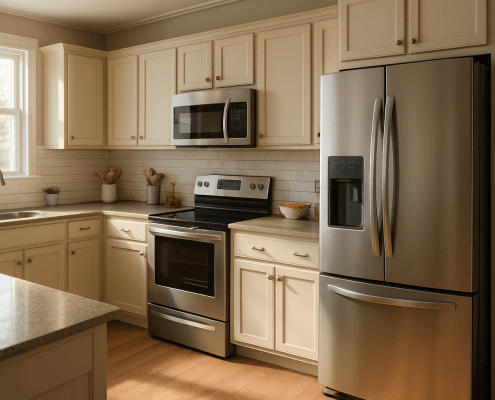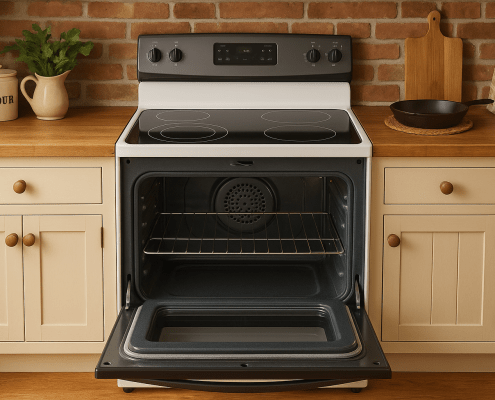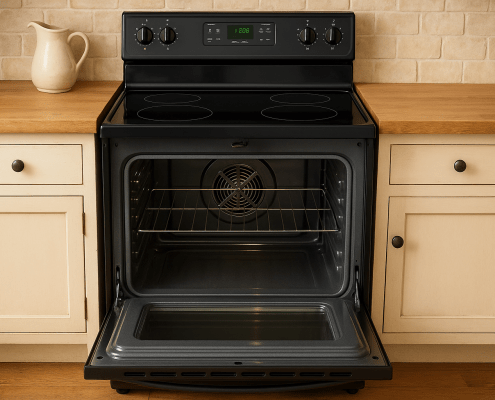Gas Range Smells Like Gas: Top 5 Reasons and Fixes (With Video!)
Steven E / Tuesday November 2, 2021
Uh-oh, is your gas range emitting a persistent gas smell? This can be a concerning issue for any homeowner, but don’t worry, it often has a straightforward fix you can tackle on your own. Dive into our comprehensive troubleshooting guide, and watch the step-by-step video below to safely address that unnerving odor and ensure your kitchen range is operating flawlessly once again.
If your gas range is producing the smell of gas, it can be scary. However, it can be a simple problem to resolve that just involves investigating the situation to get to the root of the problem. A faint smell is normal upon first lighting the range, but if it persists or gets stronger, it could be a sign of a problem. Proceed with this guide to troubleshoot a faint gas smell from your range.
Urgent: If it is suspected that there is a serious gas leak, you need to shut off all gas in the home, call the utility company, and leave immediately. If you cannot get the smell to dissipate or aren’t sure where the leak is coming from, it can be dangerous to stay in your home.
1. Oven Ignitor
If the ignitor on the stove goes bad, it will cause the gas to flow out of the range, but it may not be able to create the spark to light the flame. Igniters are fickle and often need replaced over time, which can lead them to be unable to light. If the ignition source cannot light the gas, it will continue to flow from the appliance and out into the room, which can become dangerous if left unattended.
Make sure that your pilot light is lit and that the range fires appropriately, even if you’re just preheating the oven, before you leave the unit unattended. Replacing the igniter or other components is not difficult, but it should be done by a licensed and trained professional.
2. Burner Tubes
The burner tubes in the gas range are designed to transport the gas between the gas supply and the cooktop burners. These tubes could be clogged with buildup or debris, causing the gas supply to be blocked so that it is still flowing but not igniting. This buildup of gas will create a gas smell. These usually have a compression fitting on them, but not always. You will typically have to remove everything and lift the cooktop to access these tubes.
These tubes can develop cracks or other damage over time. Be sure to inspect them carefully for physical damage. You should also use a leak detecting fluid to check the burner tubes for leaks. If you notice any leaks, the tubes will need to be replaced.
3. Cooktop Burner Valves
The burner valves are what you turn to send gas into the burner head. They usually consist of a mounting block and a valve, as well as a connecting point for the burner tube. They’re usually located right behind the control panel. Some models will allow you to see the shaft when you remove the knobs, but you’ll have to lift the cooktop to get full access. If these knobs start to go bad, you could get a gas smell because the valve isn’t opening properly when you turn the knob.
Make sure the two screws behind the switch are tight and coat the valves with the leak detector. Turn the gas on temporarily and make sure that there are no bubbles. If you see bubbles, it means that the valves are leaking and will need replaced.
4. Gas Pressure Regulator
The gas pressure regulator is responsible for controlling the gas pressure coming into the oven. These regulators include an inlet and an outlet valve and newer models even have their own shutoff valve built into the unit. The inside includes a diaphragm and spring that regulate the pressure.
The regulator is located by the safety valve inside the oven or on the back panel of the range. It could be that the regulator is leaking if you are smelling gas. Find the regulator and coat it with leak detector fluid to check for gas leaks. If you see any bubbles, that means there’s a leak in the regulator and it will need replaced. You may also see obvious signs of physical damage that could indicate the need for replacement.
5. Oven Safety Valve
The oven safety valve is responsible for preventing the gas from flowing into the oven burner if the igniter fails. These usually have a metal housing and a metal arm inside that are used to keep an eye on the pressure. There are single valves and dual valves available, depending on the oven model. It’s usually located behind the rear access panel or on top of the gas orifice by the oven burner.
If the safety valve has gone bad, this could result in a gas smell. You will need to locate the valve and then test it for leaks. Coat it with the leak detector and turn the gas on temporarily. Then, see if you notice any leaks. If you do, or if you see any obvious signs of damage, you will want to replace the oven safety valve.
Where To Find Us
If you need any replacement parts for your appliances, you can enter your model number at AppliancePartsPros.com to locate and order them quickly. Most orders arrive in just two business days, and we have tons of great information in our repair help section and YouTube videos to help you troubleshoot.
Stay connected with the latest DIY tips, tutorial videos, and repair guides by following us on Facebook, Instagram, and Twitter. We love hearing about your repair stories and successes. If you need more help or want personalized guidance, feel free to contact or call us at 877-477-7278. We’re ready to help you take on your next project with confidence!
Since 1999, AppliancePartsPros.com has helped millions of people repair their broken appliances by providing high-quality original parts at well below retail prices, free support and troubleshooting, and award-winning customer service from an expert, friendly, US-based customer support team!
With nearly a decade of experience in providing top-notch customer service regarding appliance parts and repair, Steven enjoys sharing practical advice, troubleshooting tips, and interesting information to help readers stay informed.





